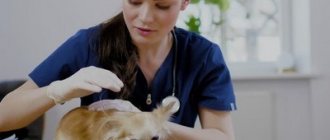The Chihuahua is a miniature dog, ideal for keeping in an apartment. Unlike most decorative breeds, these dogs are generally in good health. On average, they live up to 12-15 years, but there are also centenarians who live up to 20 years. However, the owner should be aware of the signs of possible Chihuahua diseases. Our article is devoted to a description of their features.
Chihuahua diseases: symptoms and treatment
Why does a Chihuahua tremble?
In general, for representatives of this breed, especially smooth-haired ones, trembling is a common condition. However, if your pet is shaking more or more often than usual, this is also worth paying attention to.
The dog may be shivering due to the cold
So, if the baby only trembles during walks, this means that he is freezing and it’s time for him to get dressed.
Sometimes trembling is a sign of nervous feelings. For example, if the dog has misbehaved and expects punishment or is afraid of something else. When frightened, the dog may still tuck its tail. Nervous tremors are a common occurrence and there is nothing dangerous about them.
However, in some cases, shaking can be a sign of illness. It is important to pay attention to it in time. Usually, if the shaking is unhealthy, it will be accompanied by other symptoms.
Diseases accompanied by tremor:
- hypoglycemia;
- poisoning;
- allergy;
- kidney diseases.
Additional information to answer the question why a dog is trembling can be found in the article on our website.
Video - Why do Chihuahuas tremble?
General signs of diseases
To notice that a dog is unhealthy, it is usually enough to take a closer look at its behavior and condition. It is worth paying attention to the following manifestations:
- lack of appetite or poor appetite for more than 24 hours;
- temperature is too high (38-39 degrees);
- diarrhea and vomiting;
- constipation;
- frequent sneezing, coughing;
- sudden weight loss;
- uneven breathing;
- itching, dandruff, parasites;
- bloated stomach;
- convulsions;
- discharge from the eyes, ears or nose;
- constant strong thirst;
- uncontrolled urination;
- lameness;
- lethargy, apathy, fatigue.
If you suspect a disease, contact your veterinarian
If any of these signs occur, you should take your dog to the veterinarian for an accurate diagnosis and treatment.
Alarming symptoms
- A high temperature in a dog is a common symptom of an impending illness. A temperature of thirty-eight to thirty-nine degrees is considered elevated.
- Uneven breathing (too infrequent or rapid) can also be a sign of illness.
- Vomiting is often a symptom of the disease.
- If your Chihuahua's eyes are watery or there is discharge from them, this is a sure sign of an eye disease.
- Symptoms may also include discharge from the ears and nose.
- The disease may be indicated by poor appetite, diarrhea and, as a result, weight loss.
- A dog coughing is a warning sign.
- Lameness is a good reason to visit the veterinarian.
- Various parasites, dandruff and itching can also be signs of the disease.
- If your dog does not control his urination, consult a veterinarian.
- In addition, the disease may be indicated by increased thirst and fatigue, cramps, frequent and long sleep.
Genetics
Patella dislocations and hip dysplasia in Chihuahuas can be caused by hereditary abnormal joint structure. Similar non-inherited defects are less common. With this pathology, even in childhood, the puppy begins to limp. In such a situation, the veterinarian prescribes an x-ray for an accurate diagnosis. Therapy or surgery is prescribed.
Sometimes heart pathologies, eye diseases, skin diseases, undescended testicles, and so on can be hereditary. For this reason, it is very important to purchase a puppy from reliable manufacturers in specialized nurseries with a good reputation. Responsible and respectable breeders do not allow dogs with hereditary defects to be bred.
Patella dislocations and hip dysplasia in Chihuahuas may be caused by hereditary joint abnormalities.
Attention! If the puppy is nevertheless purchased from your own hands, it is advisable to conduct a full veterinary examination so that if there are any pathologies, they can be treated as early as possible. In some situations, surgery may be required.
Breed Features
Because of their size, Chihuahuas appear to be very delicate and fragile.
This is partly true. Miniature animals have a genetic predisposition to certain diseases. Chihuahua dogs are a rather sickly breed.
Puppies are born with an open fontanel; fusion of the skull bones occurs in the first four months of life. But sometimes the fontanel remains open. Any head injury in this case can be fatal for the pet.
Dogs have a weak skeletal system, and their owners often turn to the veterinarian with fractures. You need to protect your pet from jumping from heights. It often happens that a dog is accidentally stepped on or pinched by a door.
Chihuahuas are prone to patella and elbow dislocations and are often diagnosed with hip dysplasia.
Much less often, pets have heart problems - endocarditis, mitral valve disease and pulmonary stenosis.
Animals with such problems do not reproduce.
The breed is predisposed to a number of diseases.
General signs of the disease:
- vomit;
- diarrhea;
- refusal of food and water;
- discharge from their eyes, nose or ears;
- increased body temperature;
- cough and breathing problems;
- weight loss;
- lethargy;
- itching and dandruff;
- lameness;
- convulsions.
If vomiting with foam (of any color, mixed with blood) occurs repeatedly, especially if there are other alarming symptoms, you should consult a specialist. Only in a veterinary clinic can a disease or the cause of disturbances in the gastrointestinal tract be diagnosed. This usually requires biochemistry studies, a general blood test of the animal, as well as an ultrasound of the animal’s abdominal cavity.
If vomiting occurs only in the morning on an empty stomach, owners should try feeding the dog immediately before bed - this will shorten the gap between meals. Along with this, you can give your dog lansoprazole. The dosage of the drug is individual, but it is usually customary to give 30 mg of the drug half an hour before meals once a day. This will significantly reduce the amount of hydrochloric acid.
Diet is no less important. If vomiting white foam happens quite often, you may need to think about changing your diet, in particular the food. Veterinarians often advise dog owners to add more fatty foods to their pet’s diet. Moreover, you should feed your dog more often, but in smaller portions.
To treat this symptom, choleretic drugs are also often used, for example, odeston or a folk recipe - corn silk.
To be on the safe side, deworming should be carried out, as worms can also cause foamy vomiting.
Dogs don't always sleep, sometimes they just rest. Their sleep is different from human sleep. Most of their daytime sleep is light sleep, because at the slightest unusual sound they become alert and alert. Dogs are dozing at this time, and their sleep is not deep.
All dogs, even if they are not guard dogs, watch their owners very closely. They do this practically 24 hours a day! Only at night do they completely relax and fall into deep sleep, which is necessary to rejuvenate the body and renew strength.
Strawberry pie without baking, which any housewife can get right the first time
A 92-year-old skydiver and other people breaking stereotypes about age and old age
The girl’s romantic photos were criticized, but she responded with dignity
The main feature of the Chihuahua breed that is important to know about is its very short and pointed muzzle. Because of this structure, the dog has “reverse breathing” - an irritated palate provokes a spasm of the pharynx. This syndrome is also called “reverse sneezing.”
Many owners are seriously frightened by such manifestations of their pets - the animal can suddenly strongly stretch its neck, tense its chest muscles, and strongly arch its back. At the same time, the Chihuahua convulsively gasps for air, wheezes and makes loud grunting sounds, as if he is suffocating.
Don't be afraid when your pet grunts through his nose - this is how he tries to restrain himself in order to start breathing normally again. Some owners are touched by pets that make such funny sounds.
IMPORTANT!
You have to be on your guard - there are times when Chihuahuas begin to choke. It’s better to prevent trouble - monitor your pet’s health so that he doesn’t get sick, overexcited or sad, because all these reasons can provoke strong grunting.
The disease is dangerous because it develops unnoticed. The first symptoms - apathy and lethargy - appear after a few days. Vomiting and diarrhea appear later. Without treatment, 90% of bitten animals die. About half of dogs die from intoxication if the disease is diagnosed in the later stages.
- Infectious jaundice is caused by Leptospira bacilli. The disease affects the circulatory system and internal organs of the dog. Due to internal hemorrhages, the animal vomits blood and has diarrhea interspersed with bloody mucus. Without the help of a veterinarian, the dog dies within a few days.
- Cholecystitis is an inflammatory process in the gallbladder. Pathological reflux of bile into the stomach irritates the mucous membrane. This causes an attack of nausea, the dog’s body tries to get rid of the caustic contents. Belching and vomiting with yellow foam often occurs after eating. The dog's stomach growls and swells, and diarrhea or constipation appears.
- Sometimes puppies vomit yellow foam from upper respiratory tract diseases. The reason in this case is a “kennel infection”, which affects unvaccinated young animals under the age of 3 weeks. From a constant painful dry cough, the mucous membranes become thinner, damaged, and then droplets of blood are visible in the foam.
Vomiting foam in dogs is an extremely controversial symptom. On the one hand, in some cases, it is absolutely safe and is explained by the peculiarities of the structure of the dog’s body, in others this clinical sign becomes an indicator of the presence of extremely serious diseases.
White skin often appears in animals in the morning, and this directly indicates that the dog had an empty stomach. The fact is that after eating, food is pushed through the intestines within a couple of hours. The dog’s stomach is empty, but gastric juice remains in it, and a special mucous substance forms on the walls.
The main function of this mucus is to protect the walls of the stomach from the acids contained in the gastric juice. This substance contains mucopolysaccharides and proteins. If a pet actively swallows food during a meal, a large amount of air enters the stomach, which, in turn, forms a white foamy substance together with mucus.
READ Cat diseases: symptoms and treatment
Familiarization with this mechanism of the pet's stomach allows you to understand that such a phenomenon is normal for these mammals. At the same time, the pet often experiences food cravings immediately after vomiting.
The National Sleep Foundation and most experts agree that dogs should sleep about 50 percent of their time, rest about 30 percent, and be active 20 percent.
The following Huawei smartphone models will not have Google apps
Avocado will help, but chili will harm: foods that affect bags under the eyes
We fall in love only 3 times in our lives: why only the third love brings happiness
Puppies may spend a little more time sleeping as their bodies use energy to actively grow, but when they wake up, they tend to be more active than older dogs. Your puppy may be a lot like your little one who refuses naps by crying out, “I'm not sleepy!
Older dogs may start to rest more because their bodies are not as strong as they used to be. Experts estimate that adult dogs sleep about 12 to 14 hours a day, older dogs a little more, and puppies about 18 to 20 hours.
Some breeds, such as pugs, are inherently prone to respiratory problems. Their nostrils and throat passage are narrowed. They are also much more likely to overheat, which also contributes to increased breathing. Therefore, if a dog breathes frequently with its tongue hanging out, this can be considered normal. A similar phenomenon can be observed when the body temperature rises or the neck is constrained by the collar.
Hydrocephalus
Chihuahuas are the only dogs that are born with an incompletely formed skull. They, like human newborn babies, have a fontanel. The cranial vault is finally formed only by three to four months of age. This feature predisposes the breed to hydrocephalus. It may also be due to heredity.
Chihuahuas are the only dogs that are born with an incompletely formed skull.
Symptoms of the disease are noticeable in puppies from two months. When choosing a puppy, pay attention if he often throws back and tilts his head, or becomes dizzy. Convulsions are possible.
Treatment is carried out only by a doctor. Drugs are needed to reduce intracranial pressure, and sometimes surgery.
Pregnancy and puppies
Pregnancy lasts 58–64 days. Long-term pregnancy is observed when carrying one or two puppies. The shorter the pregnancy, the more fetuses there are.
Two to two and a half weeks before birth, the puppies begin to move, which makes it possible to distinguish a true pregnancy from a false one. The fact that pregnancy is coming to an end and childbirth will soon be indicated by swelling of the loop and mucous discharge.
The behavior of newborn puppies should be monitored, as they often have hydrocephalus. Hydrocephalus develops due to the failure of the growth of the skull bones to keep pace with the increase in brain volume.
Epilepsy
The first manifestations of epilepsy are observed between the ages of 9 months and 3 years. Before an attack, the dog gets nervous and looks for a secluded corner. A convulsive attack may be accompanied by severe salivation and involuntary bowel movements. The duration of the attack is about one and a half minutes. With age they become more frequent. The disease, unfortunately, is incurable, but you can live with it. The doctor will prescribe medications to suppress seizures and select their dosage.
Epilepsy is incurable
On a note! Any noticeable seizures in a dog, even mild ones, is a reason to immediately contact a veterinarian, as this may be the first manifestation of epilepsy. You can read more about this disease in dogs in our article .
Digestive system
Digestive problems can result not only from poor nutrition, but also from hypothermia. Another common cause is overeating. Under no circumstances should a Chihuahua be overfed or fed with “goodies” from your table. Both of these ultimately lead to obesity. Obesity in Chihuahuas is a cause of chronic digestive problems, heart disease and, ultimately, a significant reduction in life expectancy.
Obesity is a common condition in Chihuahuas.
Symptoms:
- diarrhea;
- vomit;
- lethargy;
- poor appetite.
Diarrhea
Diarrhea can be a consequence of overeating, poisoning, allergies to certain foods, worms or infection. If we are talking about overeating or poisoning, the dog’s intestines are cleansed before starting therapeutic procedures. To do this, you will have to force her to drink a spoonful of castor oil. During treatment, strong tea is added to the pet's drinking water. In case of a food allergic reaction, it is necessary to exclude the product that caused it from the diet. For this reason, any new foods are introduced into the diet gradually, one at a time, so that you can immediately determine what exactly led to the reaction.
Diarrhea can be a consequence of overeating, poisoning, allergies
Attention! If the cause of diarrhea cannot be determined and eliminated, you should consult a veterinarian. Sometimes severe diarrhea can be a symptom of a serious infection.
Constipation
Constipation can occur, for example, due to dry food, coarse fiber, too strong broth, or bones. In most situations, constipation can be eliminated without visiting a veterinarian. In the easiest case, it is enough to feed the dog kefir. Other common remedies are castor oil, vegetable oil (you will have to give it forcibly) or an enema. On the recommendation of a veterinarian, lactulose-based medications can be used. To avoid frequent constipation, you should monitor your pet’s diet.
Kefir can help treat constipation in dogs
Allergies and some other problems
With improper nutrition, chihuahuas often develop allergies. Its symptoms:
- Redness of the skin;
- Itching;
- Runny nose;
- Eyes water;
- Hair loss;
- Dandruff.
Food allergies in Chihuahuas are easily treated. If the dog is on dry food, low-allergenic food is selected. If the dog is on natural food, the products are replaced.
Chihuahuas are also allergic to chemicals, medications, and dust. In most cases, there is no need to treat the pathology. It is enough to eliminate the allergenic source.
It is not uncommon for a dog to have a runny nose and watery eyes. A runny nose is mild at first, and then profuse with a pustular secretion – a sign of a fungal infection. A profuse, sticky runny nose, fever, and refusal to eat are signs of an infectious disease.
A runny nose is one of the symptoms of allergies. When foreign objects get into the nasal passages, a severe runny nose also develops. A runny nose is always a symptom of an unhealthy dog. If the runny nose does not go away, you should consult a veterinarian.
It may be food-related - the problem can be solved by reviewing the diet and selecting hypoallergenic food. Or it occurs due to dust, medications, chemicals, shampoo, etc. This type of allergy does not require treatment; when the original source of the problem disappears, it will go away on its own.
It is not uncommon for this breed to experience allergies.
Allergy symptoms are as follows:
- tearing eyes;
- itching and redness of the skin;
- runny nose;
- hair loss and dandruff.
To find out the cause of the allergy, you need to contact a dermatologist. He will help remove the source and select the right nutrition.
It happens that a Chihuahua's eyes leak excessively, and constant wet tracks lead to pigmentation of the fur under the lower eyelids and along the face. It looks untidy. In the absence of other accompanying manifestations, it can be assumed that the pet is allergic to food. If within 2-4 weeks after changing the food the situation has not improved, but has not worsened, you should pay attention to the bedding (house) where the dog sleeps. Perhaps the fabric from which the bed (house) is sewn is fleecy - fleece or fur. Long hairs irritate the convex cornea.
Particles of lint stick to it, irritating and injuring.
The litter should be changed, giving preference to smoother fabrics. Let it be corduroy, velor, etc., since the Chihuahua loves warmth and may not like completely smooth fabric. Pet supply stores always have a large number of options for pet beds.
The cardiovascular system
Heart failure is most common in older Chihuahuas. This disease can be fatal, so special attention should be paid to its first signs in order to begin treatment measures on time.
Symptoms:
- dyspnea;
- cough;
- uneven, shallow breathing;
- bluish color of the gums and tongue (appears in later stages).
Heart failure is most common in older Chihuahuas.
Respiratory system
Problems with the respiratory system can become a complication or consequence of an untreated cold. In addition, they can develop due to infection, heredity, obesity, heart pathologies and inhalation of harmful substances (cigarette smoke, gasoline exhaust, dust, household chemicals).
On a note! Coughing, uneven breathing, shortness of breath, and restless behavior may be signs of tracheal collapse.
The doctor may prescribe antibiotics or other drugs depending on the cause of the disease and its stage.
Tracheal collapse
Tracheal collapse can be either an acquired problem (due to obesity) or a congenital pathology, which can cause not only serious breathing problems, but also the death of the dog. Softening of the tracheal rings leads to its narrowing. With the development of the inflammatory process, mucus begins to accumulate in the trachea. The dog experiences attacks of suffocation, coughing, shortness of breath, and rapid breathing. The animal behaves restlessly and rushes about. The dog needs to be treated comprehensively: a special diet to eliminate obesity in parallel with medications to relieve inflammation. Timely treatment often allows the problem to be completely eliminated.
Similar article: DIY clothing patterns for Chihuahuas
Teeth and gums
Teeth are one of the weak points of this breed. It is important to regularly check their condition and start caring for them from an early age. Baby teeth may not fall out on their own, in which case they must be removed, otherwise the dog will develop an overbite. Fractures of the lower jaw are common. Caries, pulpitis, etc. are common.
Teeth are one of the Chihuahua’s vulnerable spots.
Prevention
To avoid dental diseases, she has her teeth brushed once a week. Plaque is removed at the veterinary clinic approximately once a year.
Eyes
The most common cases are progressive retinal atrophy, keratoconjunctivitis (dry eyes), glaucoma, and cataracts. Swelling, lacrimation, purulent discharge, redness, inflammation are signs of such diseases. Another possibility is loss of eyeballs due to the structure of the skull. This is possible in small puppies due to injury. In such a situation, urgent veterinary attention is needed.
Retinal atrophy in dogs
To prevent eye diseases, you should regularly examine and wipe with a cotton swab dipped in tea infusion or saline solution.
Keratoconjunctivitis
With this disease, the cornea of the eye becomes inflamed and interferes with the production of tears. As a result, the eye dries out. The result can be decreased vision and even blindness. The causes of the disease can be different - heredity, injury, infection, problems with the immune system, consequences of unsuccessful treatment of other diseases.
Keratoconjunctivitis
Symptoms:
- dull, reddened eyes;
- discharge from the eyes;
- irritation.
If your dog blinks frequently, rubs its eyes with its paw, or has difficulty opening its eyes after sleep, you should immediately consult a doctor. In advanced cases, surgery may even be necessary. In milder cases, the veterinarian will prescribe drops to moisturize the eyes and stimulate the production of natural tears.
Conservative treatment of epilepsy in Chihuahuas
Not every seizure is epilepsy. Irregular isolated cases generally do not require regular veterinary attention. This is due to the fact that drug therapy causes more harm to the Chihuahua’s health than rare isolated epileptic seizures. Treatment is indicated in the following cases:
- attacks occur more than once a month;
- seizures have a cluster (serial) nature;
- convulsions last more than 5 minutes, the animal does not come to its senses.
Based on the established diagnosis, the veterinarian will draw up a comprehensive treatment plan. If the attacks are symptomatic, then treatment is aimed at eliminating the root cause that provokes them. Treatment for true epilepsy in Chihuahuas is aimed at reducing the frequency and severity of seizures. This is precisely the primary task.
Classic antiepileptic drugs: Phenobarbital, Pagluferal, Benzonal. Potassium Bromide is prescribed as an auxiliary. These medications are prescription medications and it is not always possible to purchase them with a veterinarian's prescription.
Corvalol is used as a temporary affordable alternative - 1 drop/1 kg of weight. The product contains a small concentration of Phenobarbital. Dilute in a small amount of water. Give orally immediately after the end of the epileptic seizure.
The names of the drugs are presented for informational purposes. Their independent use is at your own peril and risk. The selection of a course of treatment for epilepsy in a Chihuahua should be carried out by a certified veterinarian based on the results of examinations.
When taking medications and having liver problems, experts recommend donating blood for a biochemical analysis once every 6 months. Based on its results, treatment is adjusted.
Demodicosis
The causative agent of this disease is the scabies mite. The disease is contagious.
Attention! Ticks that cause demodicosis are dangerous not only for dogs and other pets, but also for people.
Demodectic mange in a dog
Signs of demodicosis are hair loss, severe itching, sores on the skin, and the animal does not eat well. If a dog is diagnosed with this disease, a course of treatment will be required, which will be prescribed by a doctor. This can be a series of injections and/or external remedies (ointments, creams to fight parasites and heal the skin). The apartment urgently needs to be thoroughly cleaned and the dog bedding must be disinfected or destroyed.
Preventing health problems in Chihuahuas
Consists of the following recommendations:
- do not overcool your pet (Chihuahuas are very afraid of the cold) - this can cause a cold in the dog or problems with the lungs may occur;
- the animal should not jump from a height or stand on its hind legs - this can lead to problems with joints and bones;
- children need to be given adequate physical activity;
- it is necessary to ensure proper balanced nutrition and care;
- monitor the condition of the teeth - give various bones to clean them.
Important! Most diseases can be treated if you contact a veterinarian as soon as possible.
When getting a Chihuahua, you need to know all the intricacies of the breed and possible health problems and treat this with full responsibility. This way you can understand in time that your pet is developing some kind of disease and take action. Remember that the sooner you contact a specialist with a problem, the fewer complications your dog will have and the greater the chance of a successful outcome.











